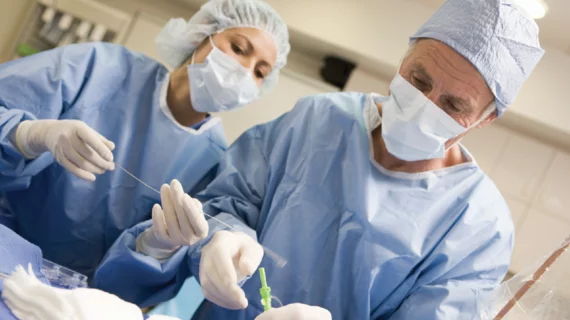Radiation exposure during structural heart procedures much higher for echocardiographers than cardiologists
Echocardiographers are exposed to higher radiation levels during structural heart procedures than cardiologists or sonographers, according to a new study published in JAMA Network Open. The analysis focused specifically on transcatheter edge-to-edge repair (TEER) and left atrial appendage occlusion (LAAO) procedures.
“Because there is a need for intermittent manipulation of the TEER probe during LAAO and TEER, the interventional echocardiographer must stand near the patient, which is the principal source of scatter radiation during fluoroscopically guided procedures,” wrote first author David A. McNamara, MD, MPH, of the Frederik Meijer Heart & Valve Institute in Grand Rapids, Michigan, and colleagues. “Long-term exposure to scatter radiation in the cardiac catheterization laboratory has been associated with multiple adverse health effects among interventional cardiologists, including premature cataract formation, early carotid atherosclerosis, and possibly left-sided brain malignant tumors. Whether interventional echocardiographers on the structural heart team are exposed to levels of radiation sufficient to pose similar adverse health risks as those faced by interventional cardiologists is not yet known.”
McNamara et al. examined data from 30 sequential LAAO and 30 sequential TEER procedures performed at a single facility from July 2016 to January 2018. The mean age of the 60 patients was 79 years old, and 53.3% were men.
The facility used “state-of-the art fluoroscopy systems with real-time image noise reduction technology.” Abbott Vascular’s MitraClip device was used for all TEER procedures, and Boston Scientific’s Watchman device was used for all LAAO procedures. Traditional lead protection, including a lead skirt, apron and thyroid collar, was worn by all specialists. Lead shields were also used.
Overall, interventional echocardiographers had a much higher median radiation dose per TEER procedure (10.5 μSv) than interventional cardiologists (0.9 μSv) or sonographers (0.0 μSv). They also had higher median radiation dose per LAAO procedure (10.6 μSv) than interventional cardiologists (3.5 μSv) and sonographers (0.2 μSv).
These findings, the team wrote, suggest that there is a “previously under-recognized occupational radiation exposure risk” that affects interventional echocardiographers.
“Taken collectively, the observations of the current study inform the interventional echocardiography and the structural heart communities of the substantially higher risk of head-level radiation exposure of interventional echocardiographers during structural intervention procedures,” the authors added. “The occupational risks depend on several factors, including the annual volume of TEE-guided fluoroscopic procedures performed, the radiation doses received during each procedure, the quality of the fluoroscopy imaging technology used, and the radiation safety practices of the institution in which the procedures take place.”
Related Imaging and Radiation Exposure Content:
An eye on imaging: How to limit radiation exposure during TAVR procedures
Salt restrictions, PCI breakthroughs and a social media primer for cardiologists: Day 1 at ACC.22
Reference:

